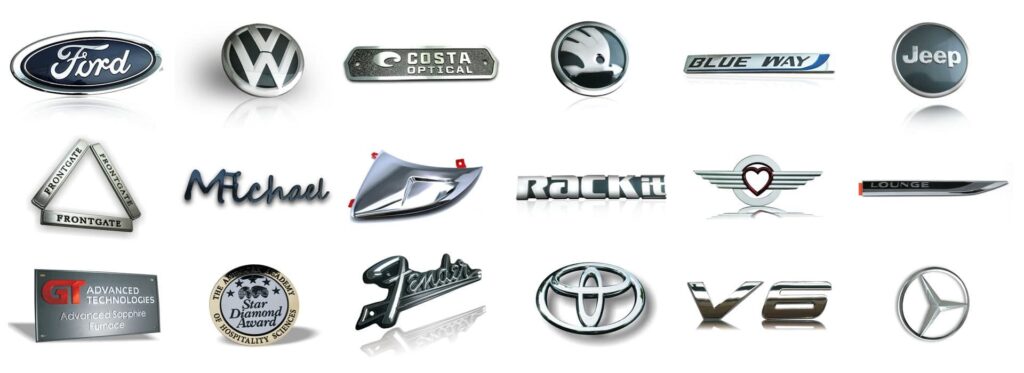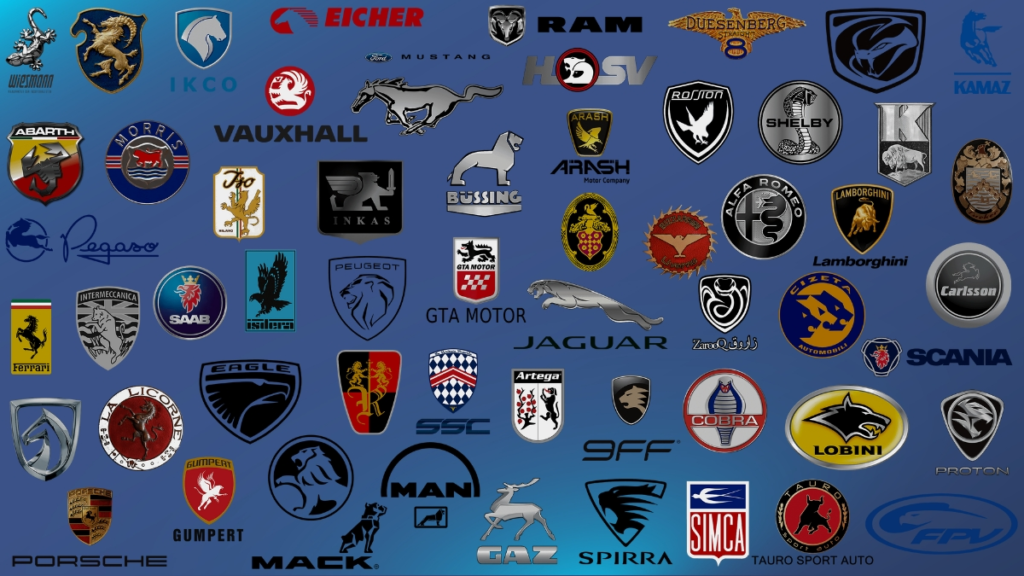What Are Auto Emblems and Badges and Why Are They Popular in Car Personalization?
Auto emblems are decorative symbols, logos, or lettering affixed to vehicles that identify manufacturers, models, or personal preferences. These accessories transform standard vehicles into personalized statements of identity.
The significance of personalized badges extends beyond mere decoration. Vehicle owners use custom Auto Emblems and Badges to distinguish their cars from identical models on the road, creating a unique visual signature. A badge might commemorate a special edition, showcase performance modifications, or simply reflect the owner’s aesthetic preferences.
The automotive customization culture has exploded into a $780 million global market, growing at 8.2% annually through 2028. This surge reflects a fundamental shift in how drivers view their vehicles—not as commodities, but as canvases for self-expression. Digital communities, social media showcases, and accessible aftermarket options have democratized car personalization, making it achievable for enthusiasts at every budget level. Custom Auto Emblems and Badges now represent the most accessible entry point into vehicle modification, requiring no mechanical expertise while delivering immediate visual impact.
What Factors Contribute to the Rising Popularity of Auto Emblems and Badges Among Car Enthusiasts?
The aftermarket customization industry is booming, with a huge demand for personalized auto emblems. This market, worth $780 million and growing at 8.2% each year until 2028, shows that consumers are willing to spend money on making their vehicles stand out from factory designs.
OEM partnerships have changed badge customization from a niche hobby into a popular trend. Manufacturers are now working together on limited-edition vehicles that feature exclusive badging, creating models that people aspire to own and inspiring a wider culture of customization. These special editions backed by factories validate personalized emblems as desirable upgrades instead of aftermarket modifications.
The Psychology Behind Badge Popularity
The reasons why badges are becoming so popular can be explained by three main motivations:
- Identity expression – Owners use badges to show their connection to car communities, performance brands, or lifestyle choices.
- Exclusivity pursuit – Custom badges help vehicles stand out in crowded markets where identical models are everywhere.
- Value perception – Premium badging gives the impression of higher quality without needing any mechanical changes.
The Role of Social Media
Social media plays a big role in amplifying these desires. Platforms like Instagram and TikTok showcase customized vehicles to audiences all over the world, turning personal modifications into content that can be easily shared. A unique badge becomes both an upgrade for the car and a symbol of status online, motivating enthusiasts to seek out even more one-of-a-kind designs.
The Impact of Accessibility
The availability of customization tools has made badge personalization accessible to more people. In the past, creating custom emblems often required professional fabrication, but now digital platforms allow consumers to design, preview, and order personalized badges within hours. This convenience breaks down traditional barriers and expands the market beyond dedicated car enthusiasts to include everyday vehicle owners who want to personalize their cars.
How Is Technology Changing the Production and Design Process of Auto Emblems and Badges?
Modern manufacturing technologies have transformed auto emblem production from labor-intensive processes into precision-driven operations. Laser engraving now delivers intricate details and complex patterns that were previously impossible to achieve, allowing manufacturers to create three-dimensional textures, micro-text, and photorealistic imagery on badge surfaces measuring just millimeters across.
The introduction of UV-resistant coatings addresses one of the industry’s most persistent challenges: environmental degradation. These specialized treatments create a protective barrier against sun exposure, preventing color fading and material breakdown. Testing data shows these coatings extend emblem lifespan by 40%, meaning badges that traditionally lasted three years now maintain their appearance for over four years under identical conditions.
Digital design platforms have compressed the development timeline dramatically. Car enthusiasts can now:
- Upload custom artwork and see instant renderings on vehicle models
- Adjust dimensions, colors, and finishes in real-time
- Receive production-ready files within hours instead of weeks
- Test multiple design variations without physical prototypes
This technological shift reduces prototype development from traditional timeframes of several weeks to mere hours, cutting costs while expanding creative possibilities. Manufacturers can respond to trending designs quickly, and individual customers gain access to professional-grade customization tools that previously required specialized design expertise.
What Materials Are Commonly Used for Personalized Car Badges and How Do They Affect Performance?
Metal Emblems
Metal emblems dominate the premium segment due to their superior durability and aesthetic appeal. Manufacturers typically use aluminum, stainless steel, or zinc alloy, with each offering distinct advantages in weight distribution and corrosion resistance. These materials withstand harsh environmental conditions while maintaining their finish for years.
ABS Plastic Badges
ABS plastic badges provide a cost-effective alternative without sacrificing visual quality. This thermoplastic polymer offers excellent impact resistance and can be molded into intricate designs that would be challenging with metal. ABS maintains structural integrity across temperature extremes, making it ideal for both tropical and arctic climates.
Carbon Fiber
Carbon fiber has emerged as the material of choice for performance-oriented enthusiasts. Its lightweight properties reduce vehicle weight while delivering a high-tech appearance that resonates with motorsport culture. The distinctive weave pattern creates an unmistakable visual signature that signals performance credentials.
Other Resources : How can we improve recycled carbon fibre? A Deakin researcher has just been awarded more than $1m in ARC funding to find out

Acrylic Badges
Acrylic badges excel in applications requiring transparency or illuminated effects. This material allows for LED backlighting integration, creating eye-catching displays that enhance nighttime visibility. The rise of auto emblems and badges in modern car personalisation has pushed acrylic innovation, with manufacturers developing formulations that resist yellowing and cracking.
Performance Standards
Performance standards mandate minimum IP67 rating for water and dust protection. Temperature tolerance spanning -30°C to 80°C ensures badges maintain adhesion and appearance whether facing Canadian winters or Arizona summers. These specifications guarantee long-term performance regardless of climate conditions.
How Do Regional Market Trends Influence the Production, Demand, and Regulations Surrounding Auto Badges?
Production Trends in the Asia-Pacific Market
The Asia-Pacific market controls 72% of global auto badge production, with China serving as the manufacturing powerhouse. Chinese facilities leverage lower production costs, advanced automation, and established supply chains to produce millions of badges annually. This dominance stems from the region’s concentration of specialized manufacturers who can rapidly scale operations to meet international orders.
Demand Patterns in North America and Europe
North America and Europe represent 68% of worldwide demand for personalized car badges, driven by mature automotive markets and strong customization cultures. North American consumers favor bold, statement-making designs, while European buyers typically prefer subtle, premium-quality emblems that complement luxury vehicle aesthetics.
Regulatory Influences on Production and Market Access
Regional regulations shape product specifications and market access:
- CE marking in Europe requires badges to meet strict safety and environmental standards, ensuring materials don’t contain harmful substances and products withstand rigorous testing protocols
- DOT FMVSS 108 regulations in North America mandate that any exterior vehicle modifications, including badges, don’t interfere with required lighting or reflective elements
Manufacturers must navigate these compliance requirements when entering different markets. A badge designed for Asian markets may require material adjustments or testing certifications before qualifying for European or North American distribution. These regulatory frameworks protect consumers while establishing quality benchmarks that elevate industry standards across all regions.
Why Do Car Owners Choose to Customize Their Vehicles With Badges? What Are Some Common Techniques for Adding or Removing Auto Emblems?
Car owners customize their vehicles with badges primarily for personal style expression and establishing unique vehicle identity. Enthusiasts use emblems to signal car culture affiliation, whether showcasing membership in specific automotive communities, displaying performance modifications, or simply differentiating their vehicle from factory-standard models. These accessories transform mass-produced vehicles into personalized statements that reflect individual taste and automotive passion.
Emblem Removal Techniques
The heat method remains the most popular approach for removing factory emblems. Owners use heat guns or hair dryers to warm the adhesive backing for 30-60 seconds, then carefully pry the emblem using plastic tools to avoid paint damage. The floss technique offers an alternative where dental floss or fishing line slides behind the emblem to cut through adhesive layers without scratching the surface.
Adhesive residue requires specialized cleaning solutions:
- Automotive adhesive removers (citrus-based formulas)
- Isopropyl alcohol for light residue
- Clay bars for stubborn remnants
Installation Methods
Rebadging involves precise placement using alignment guides and specialized 3M automotive-grade adhesive tapes rated for outdoor exposure. Professional installers recommend the three-point measurement system to ensure symmetrical positioning. Surface preparation includes thorough cleaning with isopropyl alcohol and allowing 24-hour curing time before vehicle washing to maximize bond strength and emblem longevity.
See Also : Why Epaulettes Remain Essential for Professional Uniform Branding
How The Rise Of Auto Emblems Reflects Broader Trends In Vehicle Customization
The rise of auto emblems and badges in modern car personalisation represents a significant shift where tradition meets modern customization. Heritage brand logos that have evolved over decades now exist alongside laser-engraved designs and digital customization platforms, creating unprecedented opportunities for vehicle owners to blend automotive history with contemporary aesthetics.
Empowering Individuality Through Vehicles
This movement empowers consumers to assert individuality through their vehicles in ways that were previously impossible. Digital design tools make the customization process accessible to all, allowing owners to preview modifications in real-time and order bespoke badges that reflect personal affiliations, cultural connections, or aesthetic preferences. The $780 million global market growing at 8.2% CAGR through 2028 demonstrates sustained demand for these personalization options.

Rejecting Mass-Market Uniformity
The evolution aligns perfectly with broader desires for exclusivity in aesthetics across consumer products. Vehicle owners increasingly reject mass-market uniformity, seeking distinctive touches that set their cars apart. Limited-edition OEM collaborations and aftermarket innovations respond to this demand, offering everything from carbon fiber emblems to illuminated badges.
Anticipating Future Growth
The trajectory suggests continued growth as technology advances. Emerging materials, improved weather resistance standards, and enhanced digital customization capabilities will expand possibilities. The intersection of automotive heritage and cutting-edge personalization technologies positions badge customization as a permanent fixture in vehicle culture, reflecting society’s ongoing pursuit of individual expression through personal possessions.
